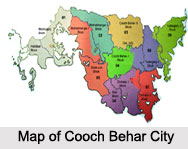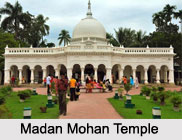 Cooch Behar is a modernized city full of tourism possibilities and formerly a Princely state, which was ruled by the Kotch Kings of Koch Dynasty, named after Kotch tribe.
Cooch Behar is a modernized city full of tourism possibilities and formerly a Princely state, which was ruled by the Kotch Kings of Koch Dynasty, named after Kotch tribe.
Naming of Cooch Behar
Cooch Behar is derived from the name of the Koch or Rajbongshi tribes, who were suppressed by the British East India Company. The word behar is derived from Sanskrit language vihara.
History of Cooch Behar
History of Cooch Behar dates back from the time of Kamarupa, Kingdom of Assam, who ruled from 4th century to 12th century. In the 12th century AD, Cooch Behar became an integral part of the Kamata Kingdom. After that, the entire Cooch Behar came under the hands of Alauddin Khilji. In later medieval era, Kotch tribe became powerful and then Koch Dynasty came into power until the British East India Company began to rule. During the rule of British Empire in India, Cooch Behar became the Princely State until independence.
Geography of Cooch Behar
 Cooch Behar is located in the foothills of Eastern part of the Himalayan Mountain Range in India. The latitudinal and longitudinal extent of Cooch Behar is about 26 degree 22 minutes north to 89 degree 29 minutes east.
Cooch Behar is located in the foothills of Eastern part of the Himalayan Mountain Range in India. The latitudinal and longitudinal extent of Cooch Behar is about 26 degree 22 minutes north to 89 degree 29 minutes east.
Climate of Cooch Behar
Cooch Behar enjoys the cool and temperate climate throughout the year. This city also receives rainfall. The temperature ranges between 20 degree Celsius and 36 degree Celsius. The months from July to September are the rainy seasons.
Demography of Cooch Behar
According to the Population Census in the year 2011, Cooch Behar had 106,760 people. Out of which 53,803 were males and 52,957 were females. Hindus, Muslims and Christians live here. The average literacy rate of Cooch Behar is 82 percent.
Education of Cooch Behar
Cooch Behar is developed with all the education facilities after Durgapur and Kolkata. Jenkins School, Sunity Academy, DIPS, Kendriya Vidyalaya, St. Mary"s H.S. School and many more are the educational institutions in Cooch Behar.
Economy of Cooch Behar
 Cooch Behar is home to a number of businesses which are mainly centered on retail managements as there is an open trade from Guwahati in Assam. While on the contrary, the outskirts of Cooch Behar are dependant on agriculture, manpower, labour management and farming.
Cooch Behar is home to a number of businesses which are mainly centered on retail managements as there is an open trade from Guwahati in Assam. While on the contrary, the outskirts of Cooch Behar are dependant on agriculture, manpower, labour management and farming.
Administration of Cooch Behar
Cooch Behar is governed by the Board of Councilors in Municipality. Cooch Behar is maintained by the member of Lok Sabha.
Culture of Cooch Behar
Cooch Behar is culturally enriched with Vaishnavism and Shatkism. Ras Purnima, Ratha Yatra, Dola Yatra or holi, Diwali, Poush Parbon, Christmas, Eid ul-Fitr and Eid ul-Adha celebrated widely.
Tourism in Cooch Behar
Cooch Behar Palace, Railway Museum, Circuit House, Sahid Bag, Bhola Ashram, Cooch Behar MJN Club, Madan Mohan Bari, Moti Mahal, Narendra Narayan Park and Debi Bari are the popular tourist destinations.
Visiting Information
Cooch Behar is connected with roadways, railways and airways. New Cooch Behar railway station is around 5 km from town and connected with Kolkata, Delhi, Mumbai, Bengaluru, Chennai and Guwahati. The nearest airport is Bagdogra Airport.



















